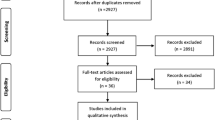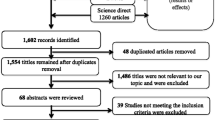Abstract
Aim
To evaluate whether the literature contains evidence, of an appropriate quality, to support the fundamental belief that there is an “optimal time” for extraction of FPMs with a poor prognosis.
Methods
A comprehensive search, limited to human studies, was performed using five databases. PICO based inclusion and exclusion criteria were employed to facilitate article selection. Three independent reviewers assessed the quality of included studies using STROBE and GRADE criteria.
Results
Initially, 56 articles were selected, of which 9 were included for final assessments. None of the included studies obtained moderate or high GRADE level rating and neither did they meet all of the STROBE requirements with only one study satisfying 95%, and another study satisfying 73%, of the requirements. The inter-observer agreement was excellent.
Conclusion
There is no scientific evidence, of an appropriate quality, to support the “optimal time” for extraction of FPMs with a poor prognosis.

Similar content being viewed by others
References
Abu Aihaija ES, Mcsheny PF, Richardson A. A cephalometric study of the effect of extraction of lower first permanent molars. J Clin Pediatr Dent. 2000;24:195–8.
Americano GCA, Jacobsen PE, Soviero VM, Haubek D. A systematic review on the association between molar incisor hypomineralization and dental caries. Int J Paediatr Dent. 2016;15:331–3.
Angle EH. The Angle system of regulation and retention of the teeth, and treatment of fractures of the maxillae. Philadelphia: The SS White dental Manufacturing Company; 1899.
Baume JL. Effect of the extraction of teeth on the deformed dentition (German). Switzerland Monthly Dentistry. 1939;49.
Cheyne VD, Drain CL. Dental caries and permanent tooth extraction: a study by age, sex, and location of the incidence of first permanent molar extraction in 8,677 school children. J Dent Res. 1940;19:571–84.
Cobourne MT, Williams A, Harrison M. A guideline for the extraction of first permanent molars in children. 2009. http://www.rcseng.ac.uk/fds/publications-clinical-guidelines/clinical_guidelines/documents/AGuidelinefortheEnforcedExtractionofFirstPermanentMolarsinChildrenrevMarch2009.pdf.
Cobourne MT, Williams A, Harrison M. National clinical guidelines for the extraction of first permanent molars in children. Br Dent J. 2014;217:643–8.
Demirjian A, Goldstein H, Tanner J. A new system of dental age assessment. Human Biol. 1973;45:211–27.
Eichenberger M, Erb J, Zwahlen M, Schätzle M. The timing of extraction of non-restorable first permanent molars: a systematic review. Eur J Paediatr Dent. 2015;16:272–8.
Enunlu N. An investigation into the effects of early extraction of first permanent molars on alveolar processes and jaw bones. In: Transactions. Europe: European Orthodontic Society; 1971. p. 439–449.
Fagrell TG, Lingström P, Olsson S, Steiniger F, Norén JG. Bacterial invasion of dentinal tubules beneath apparently intact but hypomineralized enamel in molar teeth with molar incisor hypomineralization. Int J Pediatr Dent. 2008;18:333–40.
Fox J. The natural history of the human teeth: to which is added, an account of the diseases which affect children during the first dentition, Thomas Cox, London, U.K. 1803–6.
Gill DS, Lee RT, Tredwin CJ. Treatment planning for the loss of first permanent molars. Dent Update. 2001;28:304–8.
Hallet G, Burke P. Symmetrical extraction of first permanent molars. Eur Orthodont Soc. 1961;7:238–55.
Hunter J. The natural history of the human teeth. London: J. Johnson; 1771.
Jälevik B. Prevalence and diagnosis of molar-incisor-hypomineralisation (MIH): a systematic review. Eur Arch Paediatr Dent. 2010;11:59–64.
Jälevik B, Möller M. Evaluation of spontaneous space closure and development of permanent dentition after extraction of hypomineralized permanent first molars. Int J Pediatr Dent. 2007;17:328–35.
Jourdan F. On the question of systematic extraction. Thailand (German): Schw. MfZ, 1939. p. 49.
Kantorowicz A. Extraktionsfolgen. Wien: Klinische Zahnheilk; 1924.
Lind V. Effects of systematic extraction of M1 on caries frequency. Odontologisk Revy. 1954;5:218.
Mahoney E, Ismail FSM, Kilpatrick N, Swain M. Mechanical properties across hypomineralized/hypoplastic enamel of first permanent molar teeth. Eur J Oral Sci. 2004;112:497–502.
Philips R. Investigations on extraction sequences (German). Switzerland Monthly Dentistry 1927;43.
Rahhal AA. Extraction Timing of heavily destructed upper first permanent molars. Open J Stomatol. 2014;4:161–8.
Richardson A. Spontaneous changes in the incisor relationship following extraction of lower first permanent molars. Br J Orthod. 1979;6:85–90.
Rodd H, Morgan C, Day P, Boissonade F. Pulpal expression of TRPV1 in molar incisor hypomineralisation. Eur Arch Paediatr Dent. 2007;8:184–8.
Sutcliffe P. A longitudinal study of caries experience and extraction of permanent first molars in English children. Commun Dent Oral Epidemiol. 1974;2:182–6.
Teo TK, Ashley PF, Parekh S, Noar J. The evaluation of spontaneous space closure after the extraction of first permanent molars. Eur Arch Paediatr Dent. 2013;14:207–12.
Teo TK, Ashley PF, Derrick D. Lower first permanent molars: developing better predictors of spontaneous space closure. Eur J Orthod. 2015;38:90–5.
Thilander B, Jakobsson SO, Skagius S. Orthodontic sequelae of extraction of permanent first molars. Scand Dent J. 1963;71:380–412.
Thilander B, Skagius S. Orthodontic sequelae of extraction of permanent first molars. A longitudinal study. Rep Congr Eur Orthod Soc. 1970;429–42.
Thunold, K. Early loss of the first molars 25 years after. Report of the congress. European Orthodontic Society. 1970. p. 349–365.
Wilkinson AA. The first permanent molar again. Am J Orthod Dentofac Orthop. 1940;27:156–8.
Yavuz I, Baydas B, Ikbal A, Dagsuyu IM, Ceylan I. Effects of early loss of permanent first molars on the development of third molars. Am J Orthod Dentofac Orthop. 2006;130:634–8.
Author information
Authors and Affiliations
Corresponding author
Ethics declarations
Conflict of interest
The authors declare that they have no conflict of interest.
Research involving human participants and/or animals
This article does not contain any studies with human participants performed by any of the authors.
Informed consent
Informed consent was not essential for this review.
Rights and permissions
About this article
Cite this article
Wu, M., Chen, L., Bawole, E. et al. Is there sufficient evidence to support an optimum time for the extraction of first permanent molars?. Eur Arch Paediatr Dent 18, 155–161 (2017). https://doi.org/10.1007/s40368-017-0283-y
Received:
Accepted:
Published:
Issue Date:
DOI: https://doi.org/10.1007/s40368-017-0283-y




